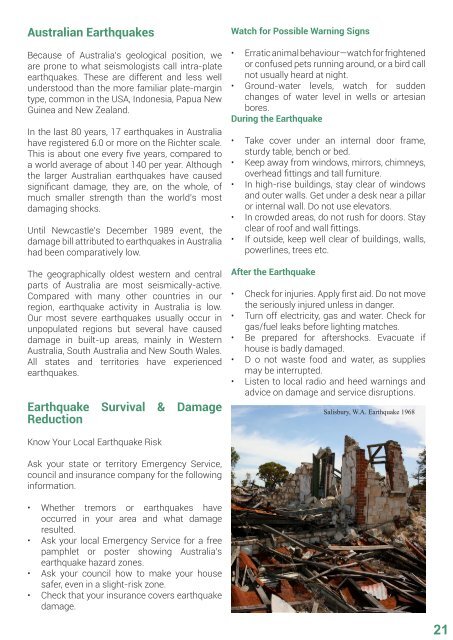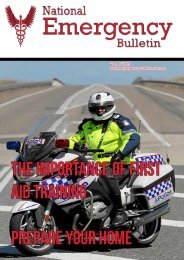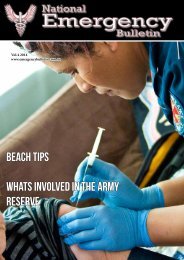Emergency Dispatch Vol 4 2014
You also want an ePaper? Increase the reach of your titles
YUMPU automatically turns print PDFs into web optimized ePapers that Google loves.
Australian Earthquakes<br />
Because of Australia’s geological position, we<br />
are prone to what seismologists call intra-plate<br />
earthquakes. These are different and less well<br />
understood than the more familiar plate-margin<br />
type, common in the USA, Indonesia, Papua New<br />
Guinea and New Zealand.<br />
In the last 80 years, 17 earthquakes in Australia<br />
have registered 6.0 or more on the Richter scale.<br />
This is about one every five years, compared to<br />
a world average of about 140 per year. Although<br />
the larger Australian earthquakes have caused<br />
significant damage, they are, on the whole, of<br />
much smaller strength than the world’s most<br />
damaging shocks.<br />
Until Newcastle’s December 1989 event, the<br />
damage bill attributed to earthquakes in Australia<br />
had been comparatively low.<br />
The geographically oldest western and central<br />
parts of Australia are most seismically-active.<br />
Compared with many other countries in our<br />
region, earthquake activity in Australia is low.<br />
Our most severe earthquakes usually occur in<br />
unpopulated regions but several have caused<br />
damage in built-up areas, mainly in Western<br />
Australia, South Australia and New South Wales.<br />
All states and territories have experienced<br />
earthquakes.<br />
Earthquake Survival & Damage<br />
Reduction<br />
Watch for Possible Warning Signs<br />
• Erratic animal behaviour—watch for frightened<br />
or confused pets running around, or a bird call<br />
not usually heard at night.<br />
• Ground-water levels, watch for sudden<br />
changes of water level in wells or artesian<br />
bores.<br />
During the Earthquake<br />
• Take cover under an internal door frame,<br />
sturdy table, bench or bed.<br />
• Keep away from windows, mirrors, chimneys,<br />
overhead fittings and tall furniture.<br />
• In high-rise buildings, stay clear of windows<br />
and outer walls. Get under a desk near a pillar<br />
or internal wall. Do not use elevators.<br />
• In crowded areas, do not rush for doors. Stay<br />
clear of roof and wall fittings.<br />
• If outside, keep well clear of buildings, walls,<br />
powerlines, trees etc.<br />
After the Earthquake<br />
• Check for injuries. Apply first aid. Do not move<br />
the seriously injured unless in danger.<br />
• Turn off electricity, gas and water. Check for<br />
gas/fuel leaks before lighting matches.<br />
• Be prepared for aftershocks. Evacuate if<br />
house is badly damaged.<br />
• D o not waste food and water, as supplies<br />
may be interrupted.<br />
• Listen to local radio and heed warnings and<br />
advice on damage and service disruptions.<br />
Salisbury, W.A. Earthquake 1968<br />
Know Your Local Earthquake Risk<br />
Ask your state or territory <strong>Emergency</strong> Service,<br />
council and insurance company for the following<br />
information.<br />
• Whether tremors or earthquakes have<br />
occurred in your area and what damage<br />
resulted.<br />
• Ask your local <strong>Emergency</strong> Service for a free<br />
pamphlet or poster showing Australia’s<br />
earthquake hazard zones.<br />
• Ask your council how to make your house<br />
safer, even in a slight-risk zone.<br />
• Check that your insurance covers earthquake<br />
damage.<br />
21





